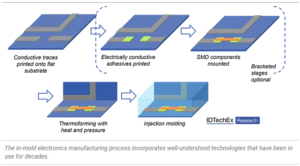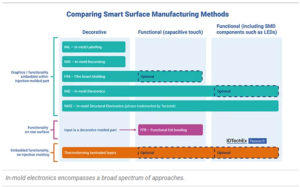In-Mold Electronics: Coming Soon to a Device Near You
(Article shared from Plastics Today
Author: Norbert Sparrow)
The technology has the potential to bring lightweight, compact, and affordable smart surfaces to automotive, consumer, and medical applications.
In-mold electronics is an emerging technology that produces multi-functional surfaces for applications in an array of industries, including consumer products, automotive, and medical technology. It has tremendous potential: Valued at $147 million in 2022, the in-mold electronics sector is projected to grow at 28.8% CAGR from 2023 to 2030 and reach $2.8 billion by 2030, according to Verified Market Research. To learn more about the technology and its reach, PlasticsToday spoke with technology analyst Matthew Dyson, PhD, who authored a report, “In Mold Electronics 2023-2033,” which was recently published by IDTechEx.
Gap-free surface piques interest of medtech OEMs
One of the advantages of in-mold electronics is that it produces a smooth surface with no gaps, making the product easy to clean. That can be especially advantageous in medical applications. Think about the conventional hospital bed, said Dyson. “There’s a little controller to move the bed up and down, and it’s typically a membrane switch, which can be wiped clean. But something is still physically moving, and the plastic eventually will crack and need to be replaced. In-mold electronics relies on capacitive touch — nothing is moving, it’s simply detecting the presence of your finger,” explained Dyson.
In-mold electronics enables capacitive touch technology to be integrated in a device compactly and, at scale, inexpensively. There is a lot of interest in the medical field, added Dyson, but because of the fairly long development cycle, we are likely to see more immediate adoption of the technology in other sectors.
The main markets for in-mold electronics initially will be automotive and appliances, according to Dyson. Because of the technology’s lightweighting and size reduction potential, aircraft interiors also represent an opportunity.
An extension of in-mold decorating process
Despite the sophistication of the end product, the manufacturing process, in some respects, is quite straightforward. “The basic idea is that you print the circuit on a flat sheet of plastic and thermoform it to create a curved surface,” explained Dyson. The process can end there, or the device can be converted into a 3D part via injection molding. It’s an extension of the well-established in-mold decorating process. Much of the existing process knowledge and equipment can be re-purposed.

“The same companies that have been doing in-mold decorating for years now are saying, ‘Oh, we can sell more expensive things by putting electronics on the back without having to invest in a whole load of extra equipment,’” Dyson told PlasticsToday. “In essence, it’s a combination of screen printing, injection molding, and thermoforming, all of which have been around for many decades. You’re just combining them with conductive inks to put circuits on the plastic sheet along with patterns.” Easy, peasy, right? Not quite.
Electronics integration, material selection among the challenges
There is the complication of integrating electronic functionality that can withstand thermoforming and injection molding. High manufacturing yield is crucial, noted IDTechEx: Because the circuitry is embedded, a single failure can render the entire part unusable.
Material selection is also critical. Currently, polycarbonate is the material of choice, according to Dyson. “You can use other materials, but that’s the main one. And the big materials suppliers will offer you special polycarbonate sheets that have been optimized for this application.”
A number of companies also are developing and selling the conductive inks, encapsulants, and adhesives that the technology requires. “Arguably, a lot of the innovation is in the materials rather than the processing steps, which are quite conventional, as I’ve noted,” said Dyson.
In-mold electronics a big tent
One thing to bear in mind, added Dyson, is that in-mold electronics is not a monolithic technology. “It covers a spectrum of approaches, from manufacturers simply putting a circuit on the back of the plastic sheet with no LEDs or resistors, to a company like Finland’s TactoTek, which is embedding everything into one enclosed part.

In the long term, however, the goal for in-mold electronics is to become an established platform technology, much like rigid printed circuit boards are today. Getting a component/circuit produced, thus, will only require sending an electronic design file rather than the expensive current process of consulting with IME specialists. Along with greater acceptance, this will require clear design rules, materials that conform to established standards, and, crucially, the development of electronic design tools, according to IDTechEx.
The report authored by Dyson and published by IDTechEx evaluates all aspects of this emerging technology, including the technical processes, material requirements, and applications.